Linear motors can accelerate heavy payloads to high speed in seconds with almost no moving parts. Plus, they offer extremely accurate positioning. With the high speed, high accuracy needs of many industrial applications, why not look into linear drive technology?
Part of the answer involves perception. Linear motors are viewed as expensive and suitable only for clean-room type applications. Plus, designing them into a system is viewed as more difficult than a rotary motor.
Another part involves components. Until recently, linear bearings that could travel 5 m/s with straightness, stiffness, and large load capacity were uncommon. Position feedback through linear encoders had its own limitations. Today’s versions, however, can handle the higher speed operation needed in applications, and they are less susceptible to noisy environments.
Newer linear motor designs blend control and mechanical technology. The direct interaction between magnet force, current, and voltage make linear motors a good choice for many applications.
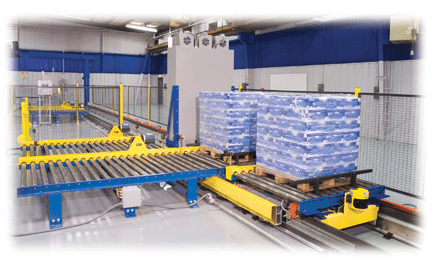
Turning tradition upside down
A more robust application of linear drive technology came about in 1997. A company known as Ward Engineering, Inc. received an order from the U.S. Postal Service that demanded a minimum throughput far greater than could be obtained by traditional mechanical drive systems. Ward engineers developed a linear drive-based device that exceeded the minimum throughput requirements by 25%, and proved to be a breakthrough in the application of linear motor technology. This fast mail-handling system used robotic end effectors mounted on a platform powered by linear drives to move cartons of mail in and out of distribution processes.
Most linear motors typically consist of a stationary motor with a moving magnet plate. The engineers flipped that idea, making the magnet track stationary and placing the motor coils on a moving platform. The engineers built a mounting for the magnet track and made a bogie cart with motor coils to ride on top of the track. The motors and magnets are common components, specified out of a catalog.
Maintaining air gap in a linear motor has always required special attention, even more so when it has to travel long distances in harsh environments. The Ward engineers solved part of this problem by using large diameter wheel bearings instead of ball-slide bearings. The recirculating bearings of ball slides often limit attainable travel speeds over linear distances. Paired with additional proprietary techniques, the wheel bearings helped maintain the needed air gap as well as reduced the need for precise installation of the rail guide. This component choice also enabled longer travel lengths. The initial design for the Post Office provided 2g acceleration with travel to 3g (50 ft/s/s) and positioning accuracy over an un-restricted distance equal to machine tool accuracy.


Replacing recirculating ball bearings with
large diameter wheel bearings helps increase system speed, maintain air
gap, and reduce the need for precise rail installation. The LTV can
reach a top speed of 1,375 ft/min.
After making refinements to this configuration, the designers formed a new company, Celerity Automation Inc., to develop practical products that use this linear drive design. The first product is the Linear Transfer Vehicle (LTV).
The LTV travels 400 ft at a speed of 18 ft/s. The payload can be as high as 20,000 lbs, and is a function of the number or size of motors mounted to the moving sled. Acceleration is 25 ft/s with positional repeatability of less than 0.010 in. This positioning accuracy is not a special-order feature. Like the air gap position control, it is a by-product of the design.
Newer control technology provides a benefit useful in this linear motor design, that of wireless communication. For this device, function commands come through infrared or radio fre- quency links, eliminating cable carriers.
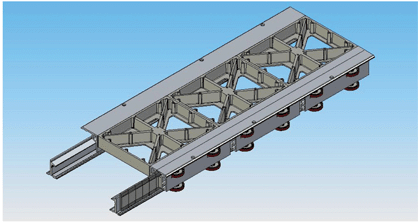
Flipping the usual linear motor configuration of a stationary platform
and moving magnet plate delivers a practical and useful linear
motor-based design.
Initial application of the LTV is for material handling and pick-to-route, pick-to-order, and pick- as well as put-in-place applications. However, if the system is turned upside down, it becomes a unirail system suitable for moving large parts to various assembly areas. With different end-effectors mounted to the sled, the basic components can also serve in press loading and un-loading, and multi-tasking machine transfer applications. The linear drive-based platform provides the speed and control for an application while the end effectors provide either the manipulative dexterity needed to pick and place product or the intelligence to record data.
Linear motors do not need to be relegated to short-stroke, clean room applications. This design proves these devices can handle much more.
www.celerityautomation.com

Celerity Automation’s designs, based on
linear motors eliminate gearing, rack and pinion and other components
that limit attainable speed because of concerns for wear. Linear
systems typically require less maintenance and overall offer high
system reliability.
:: Design World ::
Filed Under: Factory automation, Encoders • linear, MECHANICAL POWER TRANSMISSION, Motors • servo

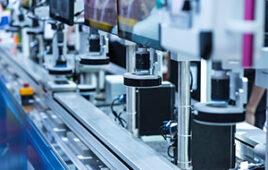

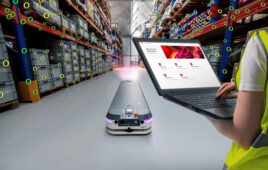
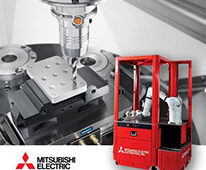
Tell Us What You Think!